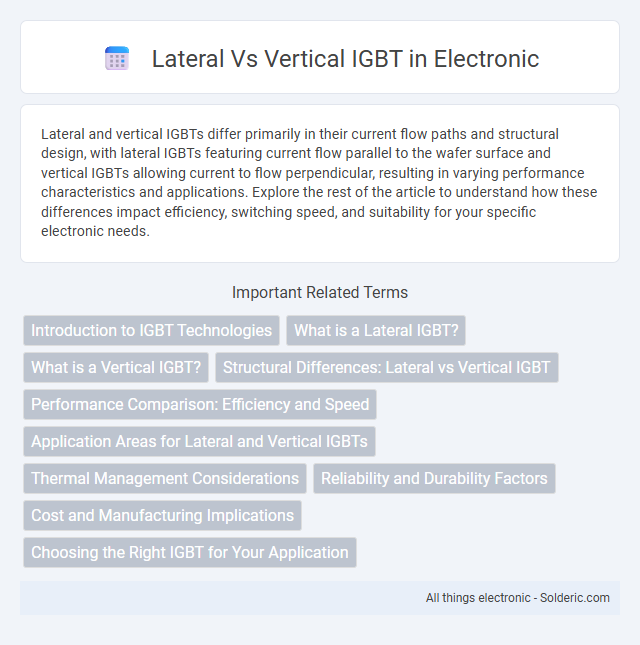Lateral and vertical IGBTs differ primarily in their current flow paths and structural design, with lateral IGBTs featuring current flow parallel to the wafer surface and vertical IGBTs allowing current to flow perpendicular, resulting in varying performance characteristics and applications. Explore the rest of the article to understand how these differences impact efficiency, switching speed, and suitability for your specific electronic needs.
Comparison Table
| Feature | Lateral IGBT | Vertical IGBT |
|---|---|---|
| Current Flow Direction | Parallel to wafer surface | Perpendicular to wafer surface |
| Voltage Rating | Lower (typically up to 600V) | Higher (up to several kV) |
| Current Handling | Lower current capacity | Higher current capacity |
| Switching Speed | Moderate speed | Higher switching speed |
| Manufacturing Complexity | Less complex, often used in ICs | More complex, requires advanced processing |
| Applications | Low-voltage ICs, integrated power devices | High power conversion, motor drives, industrial inverters |
| Size | Larger die size for the same rating | Smaller die size for the same rating |
| Thermal Performance | Limited heat dissipation | Better heat dissipation capabilities |
Introduction to IGBT Technologies
Lateral and Vertical IGBTs represent two primary transistor architectures used in power electronics, each optimized for specific applications and performance criteria. Lateral IGBTs are fabricated on the surface of the semiconductor wafer, offering advantages in ease of integration with control circuitry and suitability for low- to medium-power applications. Vertical IGBTs, constructed with current flow perpendicular to the wafer surface, provide superior current handling capabilities and higher voltage ratings, making them ideal for high-power industrial motor drives and renewable energy systems.
What is a Lateral IGBT?
A Lateral Insulated Gate Bipolar Transistor (IGBT) is a type of semiconductor device where current flows parallel to the wafer surface, unlike vertical IGBTs which conduct current perpendicularly through the substrate. Lateral IGBTs are commonly used in low-voltage applications due to their easier integration with control circuits and lower on-resistance in planar layouts. These devices offer advantages in compact power electronics, such as motor drives and switching power supplies, where efficient heat dissipation and fast switching are crucial.
What is a Vertical IGBT?
A Vertical Insulated Gate Bipolar Transistor (IGBT) features a chip structure where the current flows vertically from the top to the bottom through multiple semiconductor layers, enabling higher current densities and voltage blocking capabilities. This vertical architecture allows improved performance in high-power applications, such as industrial motor drives, renewable energy inverters, and electric vehicle systems. Vertical IGBTs typically offer lower conduction losses and better thermal management compared to lateral IGBTs, making them ideal for demanding power electronics environments.
Structural Differences: Lateral vs Vertical IGBT
Lateral and vertical IGBTs differ primarily in their structural design, impacting performance and application. Lateral IGBTs have both the emitter and collector electrodes on the same surface, enabling easy integration in low-voltage circuits but limiting current capacity and breakdown voltage. Vertical IGBTs feature a current flow perpendicular to the wafer surface, allowing higher voltage and current ratings, making them ideal for high-power applications where efficiency and thermal management are critical for Your system.
Performance Comparison: Efficiency and Speed
Vertical IGBTs generally offer higher current capacity and better efficiency due to their robust structure, making them suitable for high-power applications. Lateral IGBTs provide faster switching speeds and lower gate charge, enhancing performance in high-frequency circuits and low-voltage operations. Your choice depends on whether efficiency or switching speed is the priority in your application.
Application Areas for Lateral and Vertical IGBTs
Lateral IGBTs are commonly used in low-voltage applications such as power supplies, motor drives, and consumer electronics due to their fast switching speeds and ease of integration in ICs. Vertical IGBTs excel in high-voltage and high-current environments like industrial motor control, electric vehicles, and renewable energy systems because of their superior conduction efficiency and thermal performance. Understanding your application requirements helps determine whether a lateral or vertical IGBT offers the best balance of switching characteristics and power handling.
Thermal Management Considerations
Lateral IGBTs generally exhibit higher thermal resistance due to their planar structure, leading to localized hotspots that require efficient heat dissipation strategies such as enhanced substrate materials and optimized cooling designs. Vertical IGBTs offer superior thermal performance with lower junction-to-case thermal resistance, enabling more effective heat transfer through the chip thickness, which facilitates robust integration with heat sinks and liquid cooling systems. Effective thermal management in vertical IGBTs extends device reliability and switching efficiency, making them preferable for high-power applications demanding sustained thermal stability.
Reliability and Durability Factors
Lateral IGBTs offer enhanced thermal management due to their planar structure, improving reliability under high-frequency switching conditions. Vertical IGBTs typically exhibit superior voltage handling and current capacity, leading to greater durability in high-power applications. The choice between lateral and vertical IGBTs depends on the specific operational stresses, such as thermal cycling and electrical load, which directly impact device longevity and failure rates.
Cost and Manufacturing Implications
Lateral IGBTs generally offer lower manufacturing costs due to their simpler planar structure and compatibility with standard CMOS processes, enabling integration with other IC components on the same chip. Vertical IGBTs, while typically providing higher current capabilities and better thermal performance, require more complex fabrication steps and specialized substrates, driving up production expenses. The choice between lateral and vertical IGBTs hinges on balancing the cost-effectiveness of mass production with the specific power and thermal requirements of the application.
Choosing the Right IGBT for Your Application
Selecting the right IGBT between lateral and vertical structures depends on your application's voltage, current, and switching frequency requirements. Vertical IGBTs offer higher voltage ratings and better thermal performance, making them suitable for power-intensive industrial and automotive applications. Lateral IGBTs, with their compact design and fast switching capabilities, are ideal for low-voltage, high-frequency applications such as motor drives and power supplies.
Lateral vs Vertical IGBT Infographic

 solderic.com
solderic.com